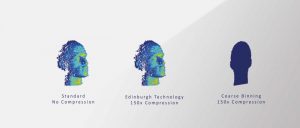
An innovative data compression framework for single photon lidar offering step-change gains in data processing and on chip memory efficiency without sacrificing depth information. Technology overcomes restrictive data transfer and computation bottlenecks to enable advances in lidar time-of-flight (ToF) imaging systems.
Application
Development Status
Commercial Offerings
Opportunity
Single photon lidar is a key enabler for depth imaging applications, including autonomous driving, advanced robotics, defence systems, smart retail and home solutions, and industrial automation. These high frame rate, high resolution use-cases drive bigger and faster detector systems, which in turn are generating massively expanding amounts of data. Conventional ToF lidar systems rely on the generation of histograms on-chip, however this can cause a critical data transfer and computational processing challenge. Alleviating these bottlenecks typically requires an unwanted trade-off – sacrificing potentially important depth resolution to reduce the amount of information to be transferred and processed. To fully exploit modern image sensor technologies we require a new paradigm for processing ToF data.
Technology
University of Edinburgh researchers have developed an efficient and hardware-friendly photon counting technique which allows massive compression of single photon lidar data without any significant loss of depth information. This technology completely by-passes the need for the on-chip histogram generation by computing a compressive statistic – a so-called sketch - of the time delay distribution for the ToF model, from which spatial distance and intensity of the object can be determined. These statistics are updated on-the-fly and require minimal computational overhead. The sketched data compression can be incorporated seamlessly into existing state of the art image reconstruction algorithms giving computational complexity that scales independently of both photon count and depth resolution parameters. The technique can be rendered effectively blind to photons originating from background sources, offers multi-peak detection performance, and can correct for range walk even at photon saturation making it robust to photon pile-up effects. Reconstruction of real-world depth images has been demonstrated using this technology with negligible loss of resolution whilst achieving 99% compression compared to full ToF data.
Benefits
Publications
“A Sketching Framework for Reduced Data Transfer in Photon Counting Lidar”, Sheehan et al, IEEE Transactions on Computational Imaging, vol. 7, 2021 DOI: 10.1109/TCI.2021.3113495
“Sketched RT3D: How to reconstruct billions of photons per second”, Tachella et al, IEEE International Conference on Acoustics, Speech and Signal Processing 2022 DOI: 10.1109/ICASSP43922.2022.9746304
“Spline Sketches: An Efficient Approach for Photon Counting Lidar”, Sheehan et al, Preprint DOI: arxiv.org/abs/2210.07314
Please note, the header image is purely illustrative.
Quote: TEC1104302

Lead Technology Transfer Manager